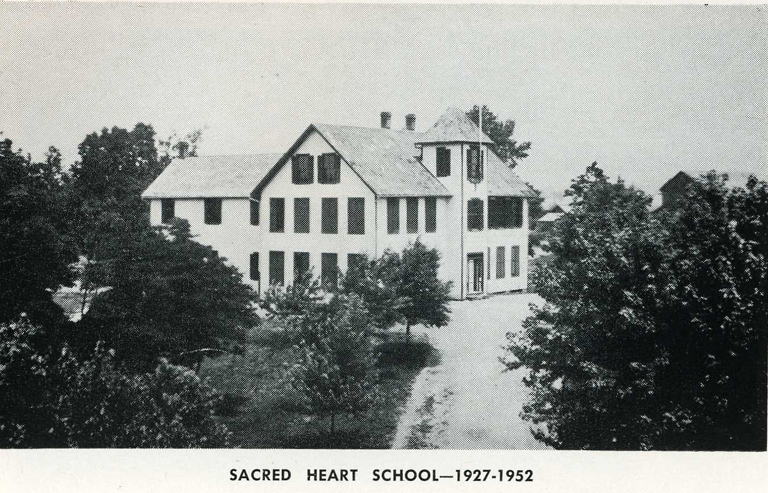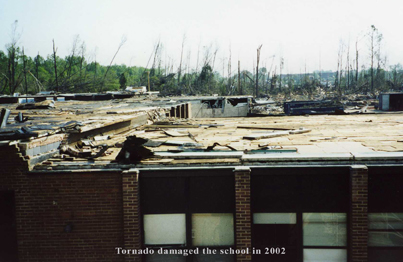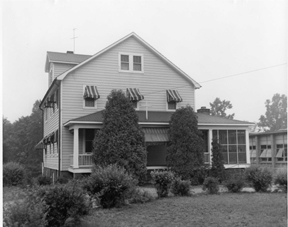Sacred Heart Elementary and High Schools, La Plata, Maryland

Published by: RoseDog Books
Natural disasters have a way of unpredictably altering the course of history and of charting a new course of events. Such was probably the case when the "great tornado" struck La Plata, Maryland, on November 9, 1926. Devastation was widespread over much of the southeastern United States. One specific disaster, however, affected the coming of the Sisters of IHM to La Plata in 1927, namely, the total demolition of a public school by the tornado while classes were in session, causing the death of twenty-two children, most of whom were Catholic.
Mother Casimir's affirmative response to the request of the pastor, Reverend Brent Matthews, SJ, of Sacred Heart Parish in Charles County, La Plata, Maryland, resulted in the opening of the second school staffed by IHM Sisters in the then Archdiocese of Baltimore. Bishop Michael J. Curley's purchase of the property of the McDonough Institute for a consolidated parochial school to serve four area Jesuit parishes brought the sisters to a very historic setting.
Maurice J. McDonough, for whom the Institute was named, had been a peddler who died in April 1804, leaving his money for the education of children in the locale in which he had worked. The trustees of the McDonough Charity School Fund, incorporated in 1804, founded the McDonough Institute, an endowed school for both sexes in the fall of 1903, one half mile west of La Plata. The Institute being the only secondary school in the county, equipped with boarding accommodations for girls as early as 1904, and for boys by 1905, was very attractive, especially to students living at a distance. There were three buildings on about thirty-five acres of land. McDonough Institute flourished until 1927 when state aid was withdrawn. (25)
It was in this setting that Sacred Heart School, La Plata, was opened on September 8, 1927, with twenty pupils in seven grades. (By the close of the year there were fifty pupils.) The school had six classrooms and a library completely furnished. The Girls' Hall, erected in 1904, became the sisters' convent. This was a three-story building with an assembly hall, office, reception room, dining room, and rooms to accommodate about forty boarding students. Into this large dwelling came the initial four sisters: Sister Benedicta O'Brien, superior, Sister Seraphia Gallagher, Sister Leo Lehman, and Sister Norberta Streilly. Sisters Maria Immaculate Yahner and Catherine Ruane came later that year. This structure served as the convent until March 2, 1935, when it was destroyed by fire caused by an explosion of the oil furnace. A new convent was built and the sisters were once again settled by August 1935.
Sacred Heart School was to grow rapidly: by September 1943, there were 207 pupils from seven area parishes. Catechetical instruction was
|
|
conducted by the sisters at Pomfert, Bel Alton, Issue, Rocky Point and Indian Head, Maryland. Since so many of the children in attendance at Sacred Heart School were from other parishes, it was decided in 1948 that these parishes should share the financial support of the school. The school was renamed Sacred Heart Consolidated School. Continued enrollment increases, together with the poor physical condition of the original school, resulted in the decision in 1952 to build a new school, a combination grade and high school, to be named "The Archbishop Neale School" in memory of Archbishop Leonard Neale, second Archbishop of Baltimore and a native son of Port Tobacco, Charles County. Sister M. Edwin Ott became the flrst principal of Archbishop Neale School, a combined grade and high school.
In the educational climate of later years, it is difficult to imagine that a high school would be opened in La Plata on September 8, 1929, with only a freshman class, and that class numbering only seventeen pupils. It is needful to think of the thirty mile distance to Washington, DC, and the lack of public transportation as a major obstacle to attendance elsewhere; it is needful to remember that the stock market crash of 1929 catapulted the world into the most severe economic depression ever known; it is needful to remember, as Hennessey states, that "American Catholics did not easily shake off the alienation and discouragement fostered by the message they seemed to be receiving in 1928." (26) By this comment, he referred, of course, to the bigotry that had beset Catholic candidate, Alfred E. Smith, in his campaign for the Democratic nomination for President of the United States in that year which caused Smith's defeat, and the rude awakening of Catholics to the fact that they were an object of mistrust and suspicion for their faith and their membership in the "Roman" Church. It was still demanded of the nation's Catholic citizens "that they establish the compatibility of their religion with American democratic ideals, laws, and practices." (27)
The action of the Catholic families of La Plata in providing for a secondary level to their parish educational offerings is very much in line with the clarion call issued by Paulist Father James Gillis, editor of the Catholic World in the December 1928 issue where he proclaimed "We Catholics shall not wither up and blow away."(28) It was a time both to "dig in" and to "reach out"; it was a time both to claim strengths and strengthen shortcomings; it was a time to gain both moral and intellectual ground. Catholic education was seen as the chief key to these goals.
These were certainly some of the reasons for the opening of Sacred Heart High School in 1929. The Department of Public Instruction of Maryland accredited this school in the following year, 1930. Each year a class was to be added to the secondary school, but not without obvious difficulties. Mother Casimir had died soon after her letter of January 23, 1929 assuring the pastor, Reverend Charles Hennessey, SJ, that she would provide for the high school: "I think for at least a year one extra Sister ought to make it very easy to begin a high school . . . " (29) Carrying out this promise fell to Mother Mary William who was pressured by Father Hennessey's strong letters to send a sister in time for the opening of school on September 8, 1929, in spite of her statement in a letter of September 1, 1929, that ''I cannot possibly send you this Sister until after the Profession at Christmas . . . "(30)
It is apparent from a subsequent letter that Mother Mary William wished to keep the promise made by Mother Casimir, so Sister Stella Devers was appointed. (31) Although Sister Stella was of frail health she had been carrying a heavy teaching load at Marywood College in Scranton, Pennsylvania, so Mother Mary William felt this change to a small class of fifteen pupils in La Plata would not overtax her. Some time in the spring, possibly in March, however, Sister Stella became ill and could not continue in school at La Plata. There was no sister available to replace her, so it is likely that through the collaborative efforts of the priests and the grade school sisters the first year was completed. Reverend William B. Hannas, SJ, pastor of St. Joseph's Church, Pomfret, Maryland, aided the fledgling high school by teaching dramatics and encouraging athletics among the students, although the school had no gymnasium. There were many strengths considering the small setting: both academic and commercial subjects were offered; there was a fully equipped science laboratory for teaching of chemistry, biology, and general science; a separate building, Brent Hall, was built in 1935 as an auditorium. Above all, there was a strong religious emphasis and many religious and academic activities.
(Renamed Archbishop Neale Elementary and High Schools)

A Tornado damaged the school in 2002
References:
25. Sister M. Immaculate Gillespie, Collected Notes on Sacred Heart, LaPlata, MD. Archives, IHM Generalate.
26. Hennessey, op. cit., p. 254.
27. Ibid., p. 253.
28. Reverend James T. Gillis, Catholic World 128 (1928), p. 357.
29. Letter from Mother Casimir to Reverend Charles Hennessey, SM, cited in his letter to Mother Mary William, dated August 31, 1929. Archives, IHM Generalate.
30. Letter from Mother Mary William to Rev. Charles Hennessey, SJ. September 1, 1929. Archives, IHM Generalate.
31. Letter from Mother Mary William to Rev. Charles Hennessey, SJ. Undated, probably Spring 1930. Archives, IHM Generalate.
 Sacred Heart Convent
Sacred Heart Convent